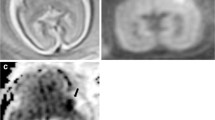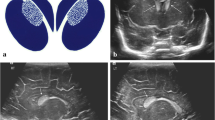Abstract
Introduction
Fetofetal transfusion syndrome is a dreaded cause of morbidity and mortality in monochorionic pregnancies.
Case reports
We present two pairs of twins one of which we have followed for more than 6 years. The donors suffer from cerebral palsy, orofacial, and motor problems, and both are significantly smaller than their recipient twins. Interestingly, cranial MRI revealed medial frontal lobe polymicrogyria, ventriculomegaly, and decreased thickness in both parietal lobes in both donors. We suggest this as a possible feature of fetofetal transfusion syndrome.
Review
A minireview of the literature on neuroimaging and neurodevelopmental outcome in fetofetal transfusion syndrome is presented.
Conclusion
While the close resemblance of the imaging features of both cases is likely incidental further study of a connection between migration and gyration disorders and fetofetal transfusion syndrome is warranted.






Similar content being viewed by others
References
Abdollahi MR, Morrison E, Sirey T, Molnar Z, Hayward BE, Carr IM, Springell K, Woods CG, Ahmed M, Hattingh L, Corry P, Pilz DT, Stoodley N, Crow Y, Taylor GR, Bonthron DT, Sheridan E (2009) Mutation of the Variant α-Tubulin TUBA8 Results in Polymicrogyria with Optic Nerve Hypoplasia. Am J Hum Genet 85 (5):737–744. https://doi.org/10.1016/j.ajhg.2009.10.007
Baschat A, Chmait RH, Deprest J, Gratacós E, Hecher K, Kontopoulos E, Quintero R, Skupski DW, Valsky DV, Ville Y (2011) Twin-to-twin transfusion syndrome (TTTS). J Perinat Med 39 (2):107–112. https://doi.org/10.1515/JPM.2010.147
Ben-Ami I, Molina FS, Battino S, Daniel-Spiegel E, Melcer Y, Flöck A, Geipel A, Odeh M, Miron P, Maymon R (2016) Monochorionic diamniotic in vitro fertilization twins have a decreased incidence of twin-to-twin transfusion syndrome. Fertil Steril 105(3):729–733. https://doi.org/10.1016/j.fertnstert.2015.11.036
Benirschke K (1990) The Placenta in Twin Gestation. Clin Obstet Gynecol 33(1):18–31. https://doi.org/10.1097/00003081-199003000-00006
Campos D, Arias AV, Campos-Zanelli TM, Souza DS, dos Santos Neto OG, Peralta CFA, Guerreiro MM (2016) Twin-twin transfusion syndrome: neurodevelopment of infants treated with laser surgery. Arq Neuropsiquiatr 74(4):307–13. https://doi.org/10.1590/0004-282X20160032
Chang YL, Chao AS, Chang SD, Lien R, Hsieh PCC, Wang CN (2012) The neurological outcomes of surviving twins in severe twin-twin transfusion syndrome treated by fetoscopic laser photocoagulation at a newly established center. Prenat Diagn 32(9):893–6. https://doi.org/10.1002/pd.3929
Cincotta RB, Gray PH, Phythian G, Rogers YM, Chan FY (2000) Long term outcome of twin-twin transfusion syndrome. Arch Dis Child Fetal Neonatal Ed 83(3):F171–6. https://doi.org/10.1136/fn.83.3.f171
De Vries LS, van Haastert IC, Benders MJNL, Groenendaal F (2011) Myth: Cerebral palsy cannot be predicted by neonatal brain imaging. Semin Fetal Neonatal Med 16(5):279–287. https://doi.org/10.1016/j.siny.2011.04.004
Delle Urban LAB, Righini A, Rustico M, Triulzi F, Nicolini U (2004) Prenatal ultrasound detection of bilateral focal polymicrogyria. Prenatal Diagnosis 24(10):808–811. https://doi.org/10.1002/pd.987
Denbow ML, Cox P, Taylor M, Hammal DM, Fisk NM (2000) Placental angioarchitecture in monochorionic twin pregnancies: relationship to fetal growth, fetofetal transfusion syndrome, and pregnancy outcome. Am J Obstet Gynecol 182(2):417–26. https://doi.org/10.1016/S0002-9378(00)70233-X
Dickinson JE, Evans SF (2000) Obstetric and perinatal outcomes from The Australian and New Zealand Twin-Twin Transfusion Syndrome Registry. Am J Obstet Gynecol 182:706–712. https://doi.org/10.1067/mob.2000.104236
Graef C, Ellenrieder B, Hecher K, Hackeloer BJ, Huber A, Bartmann P (2006) Long-term neurodevelopmental outcome of 167 children after intrauterine laser treatment for severe twin-twin transfusion syndrome. Am J Obstet Gynecol 194(2):303–308. https://doi.org/10.1016/j.ajog.2005.07.040
Gray PH, Chan FY, Cincotta R (2007) Comparing cranial ultrasound results in twin-to-twin transfusion syndrome treated with laser surgery. Am J Obstet Gynecol 196(4):e14. https://doi.org/10.1016/j.ajog.2006.10.881
Griffi PD, Bradburn M, Campbell MJ, Cooper CL, Graham R, Jarvis D, Kilby MD, Mason G, Mooney C (2016) Use of MRI in the diagnosis of fetal brain abnormalities in utero (MERIDIAN ): a multicentre, prospective cohort study. The Lancet 6736(16):8–16. https://doi.org/10.1016/S0140-6736(16)31723-8
Griffiths PD, Sharrack S, Chan KL, Bamfo J, Williams F, Kilby MD (2015) Fetal brain injury in survivors of twin pregnancies complicated by demise of one twin as assessed by in utero MR imaging. Prenat Diagn 35(6):583–591. https://doi.org/10.1002/pd.4577
Haverkamp F, Lex C, Hanisch C, Fahnenstich H, Zerres K (2001) Neurodevelopmental risks in twin-to-twin transfusion syndrome: Preliminary findings. Eur J Paediatr Neurol 5(1):21–27. https://doi.org/10.1053/ejpn.2001.0400
Johnson A (2015) Diagnosis and Management of Twin-Twin Transfusion Syndrome. Clin Obstet Gynaecol 58(3):611–31. https://doi.org/10.1097/GRF.0000000000000128
Kline-Fath BM, Calvo-Garcia MA, O’Hara SM, Crombleholme TM, Racadio JM (2007) Twin-twin transfusion syndrome: cerebral ischemia is not the only fetal MR imaging finding. Pediatric radiology 37(1):47–56. https://doi.org/10.1007/s00247-006-0337-5
Lenclen R, Ciarlo G, Paupe A, Bussieres L, Ville Y (2009) Neurodevelopmental outcome at 2 years in children born preterm treated by amnioreduction or fetoscopic laser surgery for twin-to-twin transfusion syndrome: comparison with dichorionic twins. Am J Obstet Gynecol 201(3):291.e1–291.e5. https://doi.org/10.1016/j.ajog.2009.05.036
Li X, Morokuma S, Fukushima K, Otera Y, Yumoto Y, Tsukimori K, Ochiai M, Hara T, Wake N (2011) Prognosis and long-term neurodevelopmental outcome in conservatively treated twin-to-twin transfusion syndrome. BMC Pregnancy Childbirth 11(1):32. https://doi.org/10.1186/1471-2393-11-32
Lopriore E, Deprest J, Slaghekke F, Oepkes D, Middeldorp JM, Vandenbussche FPHA, Lewi L (2008) Placental characteristics in monochorionic twins with and without twin anemia-polycythemia sequence. Obstet Gynecol 112(4):753–8. https://doi.org/10.1097/AOG.0b013e318187e1ff
Lopriore E, Nagel HTC, Vandenbussche FPHA, Walther FJ (2003) Long-term neurodevelopmental outcome in twin-to-twin transfusion syndrome. Am J Obstet Gynecol 189(5):1314–1319. https://doi.org/10.1067/S0002-9378(03)00760-9
Lopriore E, Ortibus E, Acosta-Rojas R, Le Cessie S, Middeldorp JM, Oepkes D, Gratacos E, Vandenbussche FPHA, Deprest J, Walther FJ, Lewi L (2009) Risk factors for neurodevelopment impairment in twin-twin transfusion syndrome treated with fetoscopic laser surgery. Obstet Gynecol 113(2 Pt 1):361–6. https://doi.org/10.1097/AOG.0b013e318195873e
Lopriore E, Walther FJ, Vandenbussche FP (2007) Reply. Am J Obstet Gynecol 196(4):e14–e15. https://doi.org/10.1016/j.ajog.2006.10.882
Mari G, Detti L, Oz U, Abuhamad AZ (2000) Long-term outcome in twin-twin transfusion syndrome treated with serial aggressive amnioreduction. Am J Obstet Gynecol 183(1):211–217. https://doi.org/10.1067/mob.2000.105583
Maschke C, Diemert A, Hecher K, Bartmann P (2011) Long-term outcome after intrauterine laser treatment for twin-twin transfusion syndrome. Prenat Diagn 31(7):647–53. https://doi.org/10.1002/pd.2797
Mavili E, Coskun A, Per H, Donmez H, Kumandas S, Yikilmaz A (2012) Polymicrogyria: correlation of magnetic resonance imaging and clinical findings. Child’s Nervous Syst ChNS Official J Int Society Pediatr Neurosurg 28(6):905–9. https://doi.org/10.1007/s00381-012-1703-2
Quintero RA, Morales WJ, Allen MH, Bornick PW, Johnson PK, Kruger M (1999) Staging of twin-twin transfusion syndrome. J Perinatol Official J Calif Perinat Assoc 19(8 Pt 1):550–5
Senat MV, Deprest J, Boulvain M, Paupe A, Winer N, Ville Y (2004) Endoscopic laser surgery versus serial amnioreduction for severe twin-to-twin transfusion syndrome. N Engl J Med 351(2):136–44. https://doi.org/10.1056/NEJMoa032597
Slaghekke F, Lopriore E, Lewi L, Middeldorp JM, Van Zwet EW, Weingertner AS, Klumper FJ, DeKoninck P, Devlieger R, Kilby MD, Rustico MA, Deprest J, Favre R, Oepkes D (2014) Fetoscopic laser coagulation of the vascular equator versus selective coagulation for twin-to-twin transfusion syndrome: An open-label randomised controlled trial. The Lancet 383(9935):2144–2151. https://doi.org/10.1016/S0140-6736(13)62419-8
Tarui T, Khwaja OS, Estroff JA, Robinson JN, Gregas MC, Grant PE (2012) Altered fetal cerebral and cerebellar development in twin-twin transfusion syndrome. AJNR Am J Neuroradiol 33(6):1121–6. https://doi.org/10.3174/ajnr.A2922
Tran U, Gray PH, O’Callaghan MJ (2005) Neonatal antecedents for cerebral palsy in extremely preterm babies and interaction with maternal factors. Early Hum Dev 81(6):555–61. https://doi.org/10.1016/j.earlhumdev.2004.12.009
Van Klink JMM, Slaghekke F, Balestriero MA, Scelsa B, Introvini P, Rustico M, Faiola S, Rijken M, Koopman HM, Middeldorp JM, Oepkes D, Lopriore E (2016) Neurodevelopmental outcome at 2 years in twin-twin transfusion syndrome survivors randomized for the Solomon trial. Am J Obstet Gynecol 214 (1):113.e1–113.e7. https://doi.org/10.1016/j.ajog.2015.08.033
Vanderbilt DL, Schrager SM, Llanes A, Chmait RH (2012) Prevalence and risk factors of cerebral lesions in neonates after laser surgery for twin-twin transfusion syndrome. Am J Obstet Gynecol 207(4):320.e1–320.e6. https://doi.org/10.1016/j.ajog.2012.06.031
Wagner MM, Lopriore E, Klumper FJ, Oepkes D, Vandenbussche FPHA, Middeldorp JM (2009) Short- and long-term outcome in stage 1 twin-to-twin transfusion syndrome treated with laser surgery compared with conservative management. Am J Obstet Gynecol 201(3):286.e1–286.e6. https://doi.org/10.1016/j.ajog.2009.05.034
Weisz B, Hoffmann C, Ben-Baruch S, Yinon Y, Gindes L, Katorza E, Shrim A, Bar Yosef O, Schiff E, Lipitz S (2014) Early detection by diffusion-weighted sequence magnetic resonance imaging of severe brain lesions after fetoscopic laser coagulation for twin-twin transfusion syndrome. Ultrasound Obstet Gynecol 44 (1):44–49. https://doi.org/10.1002/uog.13283
Woodward LJ, Anderson PJ, Austin NC, Howard K, Inder TE (2006) Neonatal MRI to predict neurodevelopmental outcomes in preterm infants. N Engl J Med 355(7):685–94. https://doi.org/10.1056/NEJMoa053792
Author information
Authors and Affiliations
Corresponding author
Ethics declarations
Conflict of interests
On behalf of all authors, the corresponding author states that there is no conflict of interest.
Rights and permissions
About this article
Cite this article
Ascherl, R., Sorge, I., Thome, U. et al. Severe gyration and migration disorder in fetofetal transfusion syndrome: two case reports and a review of the literature on the neurological outcome of children with lesions on neuroimaging. Childs Nerv Syst 34, 155–163 (2018). https://doi.org/10.1007/s00381-017-3595-7
Received:
Accepted:
Published:
Issue Date:
DOI: https://doi.org/10.1007/s00381-017-3595-7




